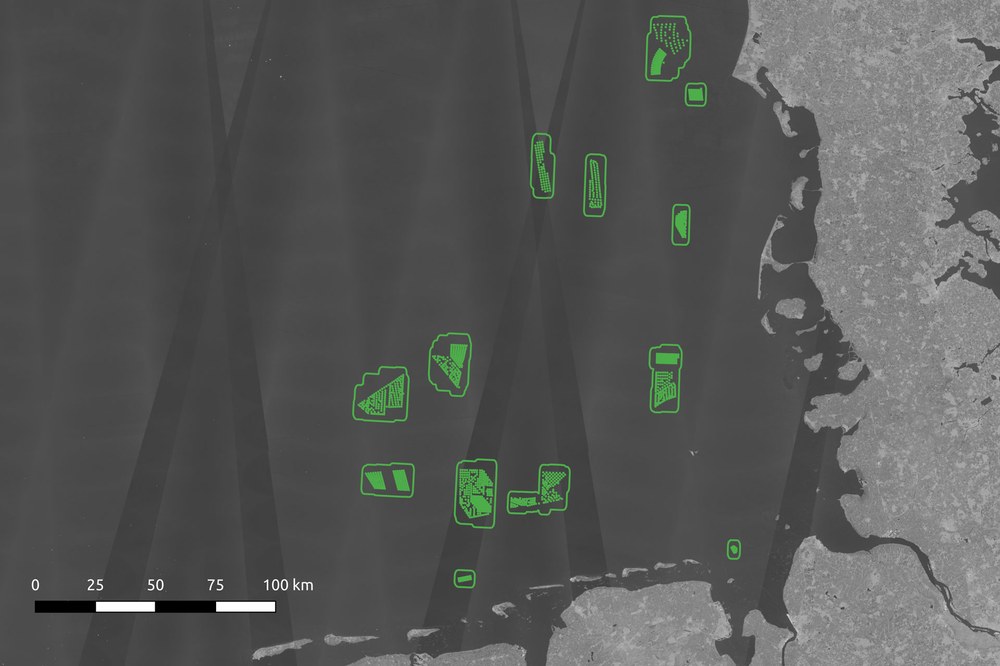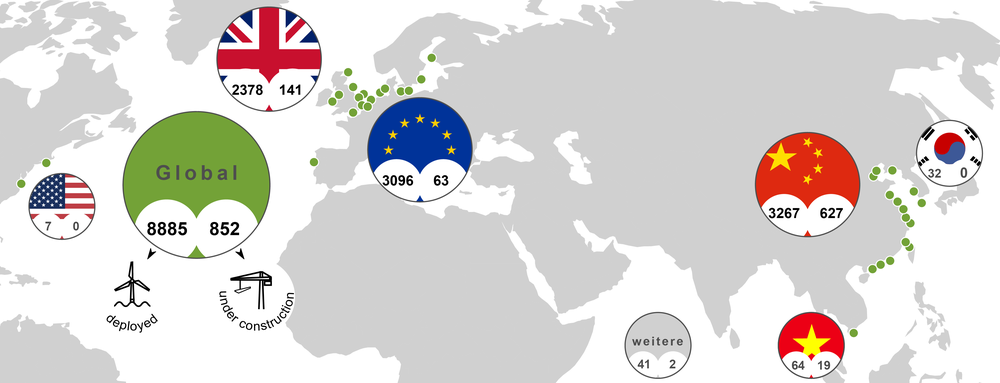China, the European Union and the United Kingdom operate the largest number of offshore wind farms



- Worldwide, the installed capacity amounts to 40.6 gigawatts – 98.5 percent of which is generated by plants in the European Union, China and the United Kingdom.
- An AI system can detect all offshore wind turbines worldwide using satellite images.
- Neural networks learn how to interpret real images using virtual examples.
- Focus: Space, digitalisation, energy, Earth observation, artificial intelligence
The European Union (EU), China and the United Kingdom (UK) operate the largest number of offshore wind farms in the world. This information is the result of an analysis of satellite data by the German Aerospace Center (Deutsches Zentrum für Luft- und Raumfahrt; DLR). The researchers used artificial intelligence (AI) to determine not only the number and locations of the plants, but also the developments over the past few years, the output and the emergence of new plants.
In June 2021, 3267 offshore wind turbines were in operation in China, 3096 in the EU and 2378 in the UK. Worldwide, 8885 turbines were in operation. The EU was ahead in terms of capacity – the offshore wind turbines in the North Sea, the Baltic Sea, the Irish Sea and in the Atlantic off the coast of Portugal had total capacity of 15.2 gigawatts. Chinese plants amounted to 14.1 gigawatts at the time, and the UK’s to 10.7 gigawatts. “Together, that is approximately 98.5 percent of the world’s installed offshore wind power capacity of 40.6 gigawatts in June 2021,” explains Thorsten Höser of the German Remote Sensing Data Center (Deutsches Fernerkundungsdatenzentrum; DFD) in Oberpfaffenhofen. By comparison, the three nuclear power plants currently still in operation in Germany have a total installed capacity of 4.3 gigawatts.
Expansion of offshore wind energy
“A look at the development over time reveals that China’s entry into the offshore wind energy sector and the construction of offshore wind farms in Chinese waters in particular have influenced the expansion dynamics,” says Höser. According to the data collected, 627 new turbines were under construction off the Chinese coast in the middle of last year. Off the EU coasts, 63 turbines were under construction. Seven existing offshore wind farms were counted off the coasts of the USA. The evaluation did not address land-based wind power plants.
“Offshore wind turbines are an important building block for greenhouse-gas-neutral energy production and at the same time support national efforts for self-sufficient energy production independent of coal and natural gas. They also have the advantage of being constructed at locations where high and steady wind speeds prevail,” says Claudia Künzer, Head of the Land Surface Dynamics Department at DFD. “In 1991, the world's first wind farm was constructed off the Danish coast. Since then, the number of offshore wind turbines has been steadily increasing in Germany, in Europe and worldwide.” The German government as well as the EU and United Kingdom are currently working to expand offshore wind energy.
Using artificial intelligence to analyse global satellite data
The analysis of satellite images makes it possible for the first time to obtain a global overview of the offshore wind energy sector. Time series from the European Space Agency (ESA) Sentinel-1 radar satellite, acquired since 2016, were used for the evaluation. The Sentinel-1 mission is characterised by repeated image acquisitions with a revisit time of just a few days.
The researchers at DFD have developed algorithms that use AI techniques – specifically machine learning – to automatically detect offshore wind turbines in the extensive Sentinel-1 data archive. This archive provided more than 11 petabytes of data in 2021. A neural network was trained with examples to recognise wind turbines. “The training examples needed to be diverse in order to present the neural network with a wide range of scenarios during learning,” explains Thorsten Höser, who led the analysis of the data. Part of the research work dealt with the creation of the examples. They describe the characteristic properties of a satellite image. Then the image properties are recombined to create tens of thousands of completely new virtual training images. This approach is transferable to other objects. In this way, other objects besides offshore wind turbines can be extracted from global satellite data archives in the future.
